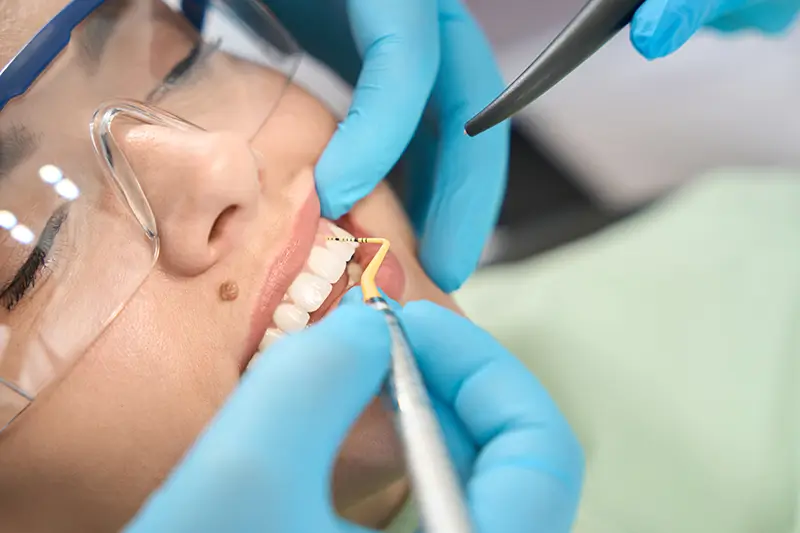Dental plaque and tartar are common dental problems that occur when saliva, food, and fluids combine to form bacteria deposits where the teeth and gums meet. The build-up of plaque and tartar can lead to tooth decay, gum inflammation or gingivitis, and other dental diseases.
Diagnosis of periodontal disease is based on an examination of the health of the periodontal tissues using a special probe, x-rays, past history of disease, and microbiological tests to assess the type of bacteria involved. Periodontal tooth scaling and root planing are nonsurgical gum disease treatments performed to remove tartar. For periodontists assessing and treating gum disease, a dental billing company can provide valuable support to bill the correct diagnosis and treatment codes for successful claim submission. With the right support, providers can avoid the challenges of billing diagnosis and treatment and get proper reimbursement.
Diagnostic Codes for Periodontal Disease
Periodontal disease is characterized by swollen and red gums that may also bleed. The gums pull away from the tooth, causing them to become loose and even fall out. If left untreated, gingivitis or early-stage periodontal disease can progress and require scaling and root planing.
Diagnosis of gum disease involves a detailed evaluation of the gums, especially looking for problems such as cavities, an abscessed tooth (tooth infection) and bone loss. ICD-10 code K05 for Gingivitis and periodontal diseases is a medical classification the WHO lists under the range – Diseases of the digestive system. Claims for coverage of scaling and root planing should have the correct ICD-10 codes to indicate a medical diagnosis.
The following ICD-10 codes can be reported on claims to indicate a diagnosis of severe gum disease that needs tooth scaling and root planing:
- K03.6 Deposits (accretions) on teeth
- K05 Gingivitis and periodontal diseases
- K05.0 Acute gingivitis
- K05.00 …… plaque induced
- K05.01 …… non-plaque induced
- K05.1 Chronic gingivitis
- K05.10 …… plaque induced
- K05.11 …… non-plaque induced
- K05.2 Aggressive periodontitis
- K05.20 …… unspecified
- K05.21 Aggressive periodontitis, localized
- K05.211 …… slight
- K05.212 …… moderate
- K05.213 …… severe
- K05.219 …… unspecified severity
- K05.22 Aggressive periodontitis, generalized
- K05.221 …… slight
- K05.222 …… moderate
- K05.223 …… severe
- K05.229 …… unspecified severity
- K05.3 Chronic periodontitis
- K05.30 …… unspecified
Scaling and Root Planing Procedure
Tooth scaling and root planing is a deep-cleaning, nonsurgical procedure to address plaque and tartar. Scaling involves scraping away the plaque and tartar from above and below the gum line. Planing is smoothing the rough spots on the tooth root. Scaling and root planing removes the bacteria and provides a clean surface for the gums to reattach to the teeth.
Scaling and root planing is typically provided on an outpatient basis using local anesthesia. The procedure is done using traditional tools, including a scaler and a curette. Lasers and ultrasonic devices are also used for teeth scaling.
CDT Codes for Scaling and Root Planing and Claim Submission Challenges
Based the diagnosis and the patient’s specific requirements, two CDT codes commonly used for billing scaling and root planing are:
- D4341 Periodontal Scaling and Root Planing- four or more teeth per quadrant
- D4342 Periodontal Scaling and Root Planing- one to three teeth per quadrant
The American Dental Association highlights several challenges when reporting these codes and that denials can occur even when the patient has abnormal pocket depths. The ADA lists the challenges of submitting claims for scaling and root planing as follows:
- Lack of clarity: One main challenge is that payer policies lack clarity. The ADA points out that “he same payer may reimburse a claim on a patient with 4mm pockets but at other times, may deny the same procedure for another patient who had the same or similar clinical presentation.”
- Absence of specific payment guidelines: Payers may not provide specific payment guidelines. For e.g., the same payer may reimburse various employee groups differently. They may modify their payment for scaling and planing for an employer based on that employer’s:
- preferred or negotiated benefit design
- analysis of the employer’s claims history, or
- recommendations of their benefits consultant.
- Criteria vary by payer: Though a pocket depth of 4mm or greater is the most commonly recognized indicator in the literature for scaling and root planing, payers create their own criteria on the specifics of pocket depths. These criteria can differ from payer to payer.
The ADA also emphasizes the importance of submitting clear and comprehensive documentation to prevent denials. Billing codes D4341 or D4342 for more than 2 quadrants within a single dental visit will usually lead payers to request additional information such as a full-mouth periodontal charting, full-mouth X-ray, periodontal diagnosis and the treatment plan.
Other Related CDT Codes and Guidelines:
D4346 – Scaling in presence of generalized moderate or severe gingival inflammation – full mouth, after oral evaluation.
This code should be used to report removal of plaque, calculus and stains from supra- and sub-gingival tooth surfaces when there is generalized moderate or severe gingival inflammation in the absence of periodontitis. It is used for patients who have swollen, inflamed gingiva, generalized suprabony pockets, and moderate to severe bleeding on probing. D4346 should not be reported in conjunction with prophylaxis, scaling and root planing, or debridement procedures.
D4355 – Full Mouth Debridement to enable a comprehensive oral evaluation and Diagnosis on a subsequent visit.
The procedure is needed when proper access to tooth surfaces or periodontal areas is not possible due to excessive plaque and calculus. These deposits prevent a thorough evaluation of the patient’s teeth and supporting gingival structures.
Full mouth debridement involves the preliminary removal of plaque and calculus that prevents the dentist from performing a comprehensive oral evaluation. Submitting the evaluation on the same day as D4355, will result in the code being denied. The patient will need a subsequent visit to complete the examination.
4910 – Periodontal Maintenance
This procedure involves removal of the bacterial plaque and calculus from supragingival and subgingival regions, scaling and root planing where required, and polishing the teeth. It is done after periodontal therapy and continues for the life of the dentition. To prevent denials, the ADA recommends the following:
- If there are unusual circumstances that require a different interval of treatment than the one specified in the patient’s plan documents, the dentist should provide documentation with the original claim submission.
- If a patient is covered under a new group policy, submitting the patient’s history of treatment with the initial claim for D4910 will help with the determination.
Additional diagnostic and treatment procedures must be considered if new or recurring periodontal disease develops.
Dental Billing Services for Accurate Coding and Claim Submission
With the many challenges involved in billing and coding scaling and root planing, outsourcing the task to an expert is a practical way to ensure correct coding and claim submission. Dental billing service providers will ensure that claims are submitted using the latest codes and in keeping with payer requirements. To prevent denials, it’s also important to ensure that claims are submitted with proper periodontal charting.




